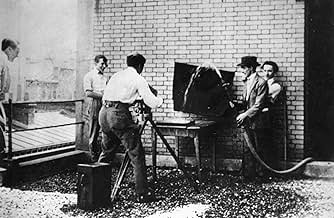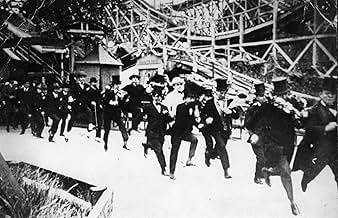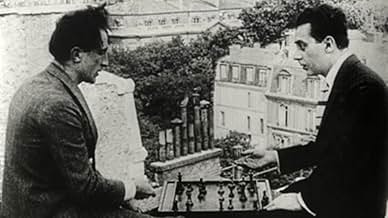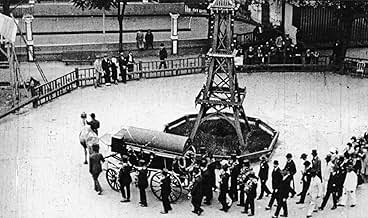Entr'acte
- 1924
- 22m
IMDb RATING
7.3/10
4.4K
YOUR RATING
An absolute dada movie. Somebody gets killed, his coffin gets out of control and after a chase it stops. The person gets out of it and let everybody who followed the coffin dissapear.An absolute dada movie. Somebody gets killed, his coffin gets out of control and after a chase it stops. The person gets out of it and let everybody who followed the coffin dissapear.An absolute dada movie. Somebody gets killed, his coffin gets out of control and after a chase it stops. The person gets out of it and let everybody who followed the coffin dissapear.
Inge Frïss
- La ballerine
- (as Mlle Frïss)
Man Ray
- Un joueur d'échecs
- (as Man-Ray)
Marcel Achard
- Un homme qui suit le corbillard
- (uncredited)
Georges Auric
- Un homme qui suit le corbillard
- (uncredited)
Georges Charensol
- Un homme qui suit le corbillard
- (uncredited)
Georges Lacombe
- Un homme qui suit le corbillard
- (uncredited)
Roger Le Bon
- Un homme qui suit le corbillard
- (uncredited)
Jean Mamy
- Un homme qui suit le corbillard
- (uncredited)
Rolf de Maré
- Un homme qui suit le corbillard
- (uncredited)
Erik Satie
- Un homme qui charge le canon
- (uncredited)
Pierre Scize
- Un homme qui suit le corbillard
- (uncredited)
Louis Touchages
- Un homme qui suit le corbillard
- (uncredited)
- Director
- Writers
- All cast & crew
- Production, box office & more at IMDbPro
Featured reviews
Rene Clair and the Marx Brothers once decided to make a movie together: it's a shame that it never happened. Maybe that movie exists in some alternate universe, and I'll bet it's hilarious. I enjoyed "Entr'acte", but I'd gladly trade this film for a chance to see Rene Clair's Marx Brothers movie.
Another IMDb reviewer has synopsised the plot, such as it is: a man apparently dies. After his funeral, his coffin escapes from its hearse, and then the man returns to life. The title "Entr'acte" (an interval between theatrical acts, or an intermission) is never explained; maybe it refers to the interval between that man's two lives. I prefer to think that Clair meant this somewhat amateurish film as a mere intermission: an amusing bit of fun between the acts of his 'real' films; the ones with coherent story lines.
Some of the content in this film truly does seem to be unintentional. After the central character's funeral, there's a stiff wind blowing outside the chapel. The women in this movie wear elaborate long dresses, and the wind animates their clothing in a way that's distracting rather than funny, and surely not meant to be symbolic.
Much of the imagery in this movie seems to be pure Dada rather than signifying anything. The man's funeral cortege is led by a camel. If there's any underlying significance there, I doubt that it amounts to much. Earlier on, I was intrigued by one sequence featuring Parisian chess players. While the camera focuses on the chessboard, a shot of Parisian traffic is superimposed: suggesting that all humanity are pawns in some cosmic chess game.
Don't look for too much meaning in "Entr'acte". It's an amusing experiment, but might have been more effective at a shorter length.
Another IMDb reviewer has synopsised the plot, such as it is: a man apparently dies. After his funeral, his coffin escapes from its hearse, and then the man returns to life. The title "Entr'acte" (an interval between theatrical acts, or an intermission) is never explained; maybe it refers to the interval between that man's two lives. I prefer to think that Clair meant this somewhat amateurish film as a mere intermission: an amusing bit of fun between the acts of his 'real' films; the ones with coherent story lines.
Some of the content in this film truly does seem to be unintentional. After the central character's funeral, there's a stiff wind blowing outside the chapel. The women in this movie wear elaborate long dresses, and the wind animates their clothing in a way that's distracting rather than funny, and surely not meant to be symbolic.
Much of the imagery in this movie seems to be pure Dada rather than signifying anything. The man's funeral cortege is led by a camel. If there's any underlying significance there, I doubt that it amounts to much. Earlier on, I was intrigued by one sequence featuring Parisian chess players. While the camera focuses on the chessboard, a shot of Parisian traffic is superimposed: suggesting that all humanity are pawns in some cosmic chess game.
Don't look for too much meaning in "Entr'acte". It's an amusing experiment, but might have been more effective at a shorter length.
We were shown this film in a class where at least once during each class, I start to nod off to sleep. Maybe it's the time of day, or the too-dark lights, but even during one of the Jean Vigo films we saw it didn't grab me. This one did, however, as it is one of the best short films of the 20's, or at least one of the more ambitious ones of the time. There are plenty of Freudian symbols, or maybe spoofs and in-jokes on the symbols (i.e. phallic imagery, cannons, guns, balls, and obsessions with looking up women's skirts).
But more importantly there is an almost need to break through anything expectable. Unlike Bunuel's Un Chien Andalou, however, Entr'acte even goes for the manic and cartoon-like. Like Bunuel's film, there COULD be a certain thread of a story in the proceeding, if you try to take one to mind- here the story could be the unexpected tragedy of death turned up on its own head. However there is also the latter part of the film, which involves a large group running after (in trademark, hilarious fast-motion film) a hearse running down a road. It's a kind of peak of stimulating silent-film cinema, where everything being done can now be just as easily done- and is- on a daily basis by music video directors.
Yet Clair is so inventive with his techniques, of pushing a speed and tempo with his style, that it works well despite making no sense on the surface. It's a film made in the heights of French impressionism and surrealism, and the almost sheer confidence of the filmmaker here propels it into being unforgettable in a way. Most will seek out the Bunuel early works first, of course, but along the way this is worth a shot. At the least, you'll have your own interpretation once its done, not shoved down your throat.
But more importantly there is an almost need to break through anything expectable. Unlike Bunuel's Un Chien Andalou, however, Entr'acte even goes for the manic and cartoon-like. Like Bunuel's film, there COULD be a certain thread of a story in the proceeding, if you try to take one to mind- here the story could be the unexpected tragedy of death turned up on its own head. However there is also the latter part of the film, which involves a large group running after (in trademark, hilarious fast-motion film) a hearse running down a road. It's a kind of peak of stimulating silent-film cinema, where everything being done can now be just as easily done- and is- on a daily basis by music video directors.
Yet Clair is so inventive with his techniques, of pushing a speed and tempo with his style, that it works well despite making no sense on the surface. It's a film made in the heights of French impressionism and surrealism, and the almost sheer confidence of the filmmaker here propels it into being unforgettable in a way. Most will seek out the Bunuel early works first, of course, but along the way this is worth a shot. At the least, you'll have your own interpretation once its done, not shoved down your throat.
I watched Entr'acte (1924) during my first encounter with underground films, specifically in its avant-garde subgenre from the 1920s. This film, along with Buñuel-Dali's Un Chien Andalou (1927), immediately captivated me. Concurrently, I was studying Maya Dere's films, which inspired me to start creating my own underground/amateur/experimental short films between 2012 and 2015.
In Sheldon Renan's book on Underground Film, Entr'acte is considered one of the most impressive avant-garde films ever made. Renan labels it a "predecessor" of the underground film movement, which was then categorized as avant-garde. Entr'acte truly deserves this recognition because, considering the etymology of the term, it was undoubtedly a film ahead of its time. It stood apart from the mainstream Hollywood productions that dominated the era. René Clair, Man Ray, and Marcel Duchamp were acutely aware of the offerings to the strict bourgeois elite in Paris during a ballet concert. In the interlude between acts, they courageously introduced surrealist and dadaist ideas in film, challenging the norms of the time. This act demonstrated that Europe, particularly France, could also pioneer something revolutionary in this art form, breaking away from the conventions of Hollywood and mainstream cinema.
I would like to point out a particular scene in Entr'acte that could be interpreted as a metaphor for this subtle opposition to mainstream Hollywood and commercial films. In this scene, a man in Entr'acte fires a bullet from a shotgun directly at a balloon, which releases a dove. This imagery serves as a metaphor for liberation from the rigidity of standards not only within hegemonic Hollywood but also in cinema at large. It symbolizes the beginning of a new era, marked by the freedom to experiment with various forms and aesthetics. This period reached its peak in the 1960s, embracing a wide range of films that, while diverse in aesthetics, shared the spirit of freedom to explore cinematic possibilities. These filmmakers and artists, along with their successors, played a crucial role in advancing film techniques, many of which were developed specifically for their unconventional creations.
In Sheldon Renan's book on Underground Film, Entr'acte is considered one of the most impressive avant-garde films ever made. Renan labels it a "predecessor" of the underground film movement, which was then categorized as avant-garde. Entr'acte truly deserves this recognition because, considering the etymology of the term, it was undoubtedly a film ahead of its time. It stood apart from the mainstream Hollywood productions that dominated the era. René Clair, Man Ray, and Marcel Duchamp were acutely aware of the offerings to the strict bourgeois elite in Paris during a ballet concert. In the interlude between acts, they courageously introduced surrealist and dadaist ideas in film, challenging the norms of the time. This act demonstrated that Europe, particularly France, could also pioneer something revolutionary in this art form, breaking away from the conventions of Hollywood and mainstream cinema.
I would like to point out a particular scene in Entr'acte that could be interpreted as a metaphor for this subtle opposition to mainstream Hollywood and commercial films. In this scene, a man in Entr'acte fires a bullet from a shotgun directly at a balloon, which releases a dove. This imagery serves as a metaphor for liberation from the rigidity of standards not only within hegemonic Hollywood but also in cinema at large. It symbolizes the beginning of a new era, marked by the freedom to experiment with various forms and aesthetics. This period reached its peak in the 1960s, embracing a wide range of films that, while diverse in aesthetics, shared the spirit of freedom to explore cinematic possibilities. These filmmakers and artists, along with their successors, played a crucial role in advancing film techniques, many of which were developed specifically for their unconventional creations.
10m67165
This is it, for me! Absolute pure cinematic fun! This movie is not trying to tell you a story, although there is a plot about a funeral that ends up transforming into some unexpected events. I just had to laugh, and also marvel at some images that are simply beautiful, like some sort of silent visual music.
What the director does is basically a collage of absurd images and some camera tricks. These involve some artists of the time. I must say I am quite surprised by its freshness even today. Now I know where musical video clips come from! The first time I saw it, I was going to see some old silent movies, and this one was shown first, and I had no idea what it was all about. In a way, I still don't, and that's even better! Stop making sense for a while and start the fun!
What the director does is basically a collage of absurd images and some camera tricks. These involve some artists of the time. I must say I am quite surprised by its freshness even today. Now I know where musical video clips come from! The first time I saw it, I was going to see some old silent movies, and this one was shown first, and I had no idea what it was all about. In a way, I still don't, and that's even better! Stop making sense for a while and start the fun!
This is an avant-garde movie and as such it's theme and plot are unclear, which is as intended because the movie is ore about special effects than about telling an actual story. This movie directs the audiences' attention to such everyday occurrences as movement, personal interactions, dancing, and running. People are part of some kind of funeral procession, but what catches the attention is the various actions that take place as the procession proceeds. Mourning is replaced by an almost frenetic need to stay active, and the movie shows this through the use of some innovative techniques, including slow-motion, use of montage, and multiple superimposed exposures, all of which convey the sense that something intense is happening. This movie is an excellent example of the French avant-garde genre which had a major influenced on cinematic styles in Europe and the United States.
Did you know
- TriviaThe ballet "Relâche" ("Theatre Closed") premiered at the Théâtre des Champs Elyseés in Paris on December 4, 1924. Based on a book and with settings by Francis Picabia, it was a ballet in two acts commissioned and staged by the Ballets Suédois of Rolf de Maré, with choreography by Jean Börlin. As the title "Entr'acte" implies, this film was shown between the two acts, with music by Erik Satie.
- GoofsObvious stand-in for the close-up of Rolf de Maré getting kicked in head, which sends him (via reverse motion) flying back into the end title. The "kick" itself is clearly achieved through reverse motion.
- Alternate versionsThere is an Italian edition of this film on DVD, distributed by DNA Srl (2 Films on a single DVD). The film has been re-edited with the contribution of film historian Riccardo Cusin. This version is also available for streaming on some platforms.
- ConnectionsEdited into Avant-garde Cinema (1960)
Details
- Runtime
- 22m
- Color
- Sound mix
- Aspect ratio
- 1.33 : 1
Contribute to this page
Suggest an edit or add missing content























